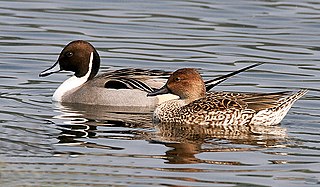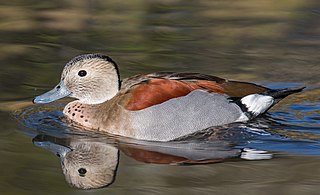
The pintail or northern pintail is a duck species with wide geographic distribution that breeds in the northern areas of Europe and across the Palearctic and North America. It is migratory and winters south of its breeding range to the equator. Unusually for a bird with such a large range, it has no geographical subspecies if the possibly conspecific duck Eaton's pintail is considered to be a separate species.

The northern shoveler, known simply in Britain as the shoveler, is a common and widespread duck. It breeds in northern areas of Europe and across the Palearctic and across most of North America, wintering in southern Europe, the Indian subcontinent, Southeast Asia, Central, the Caribbean, and northern South America. It is a rare vagrant to Australia. In North America, it breeds along the southern edge of Hudson Bay and west of this body of water, and as far south as the Great Lakes west to Colorado, Nevada, and Oregon.

The mallard or wild duck is a dabbling duck that breeds throughout the temperate and subtropical Americas, Eurasia, and North Africa. It has been introduced to New Zealand, Australia, Peru, Brazil, Uruguay, Argentina, Chile, Colombia, the Falkland Islands, and South Africa. This duck belongs to the subfamily Anatinae of the waterfowl family Anatidae. Males have green heads, while the females have mainly brown-speckled plumage. Both sexes have an area of white-bordered black or iridescent purple or blue feathers called a speculum on their wings; males especially tend to have blue speculum feathers. The mallard is 50–65 cm (20–26 in) long, of which the body makes up around two-thirds the length. The wingspan is 81–98 cm (32–39 in) and the bill is 4.4 to 6.1 cm long. It is often slightly heavier than most other dabbling ducks, weighing 0.7–1.6 kg (1.5–3.5 lb). Mallards live in wetlands, eat water plants and small animals, and are social animals preferring to congregate in groups or flocks of varying sizes.

The Eurasian teal, common teal, or Eurasian green-winged teal is a common and widespread duck that breeds in temperate Eurosiberia and migrates south in winter. The Eurasian teal is often called simply the teal due to being the only one of these small dabbling ducks in much of its range. The bird gives its name to the blue-green colour teal.

The American teal or green-winged teal is a common and widespread duck that breeds in the northern areas of North America except on the Aleutian Islands. It was considered conspecific with the Eurasian teal for some time, but has since been split into its own species. The American Ornithological Society continues to debate this determination; however, nearly all other authorities consider it distinct based on behavioral, morphological, and molecular evidence. The scientific name is from Latin Anas, "duck" and carolinensis, "of Carolina".

The American black duck is a large dabbling duck in the family Anatidae. It was described by William Brewster in 1902. It is the heaviest species in the genus Anas, weighing 720–1,640 g (1.59–3.62 lb) on average and measuring 54–59 cm (21–23 in) in length with an 88–95 cm (35–37 in) wingspan. It somewhat resembles the female and eclipse male mallard in coloration, but has a darker plumage. The male and female are generally similar in appearance, but the male's bill is yellow while the female's is dull green with dark marks on the upper mandible. It is native to eastern North America. During the breeding season, it is usually found in coastal and freshwater wetlands from Saskatchewan to the Atlantic in Canada and the Great Lakes and the Adirondacks in the United States. It is a partially migratory species, mostly wintering in the east-central United States, especially in coastal areas.

The blue-winged teal is a species of bird in the duck, goose, and swan family Anatidae. One of the smaller members of the dabbling duck group, it occurs in North America, where it breeds from southern Alaska to Nova Scotia, and south to northern Texas. It winters along the Pacific and Atlantic coasts and south into the Caribbean islands and Central America.

The wood duck or Carolina duck is a species of perching duck found in North America. The drake wood duck is one of the most colorful North American waterfowls.

The greater scaup, just scaup in Europe or, colloquially, "bluebill" in North America, is a mid-sized diving duck, larger than the closely related lesser scaup. It spends the summer months breeding in Alaska, northern Canada, Siberia, and the northernmost reaches of Europe. During the winter, it migrates south to the coasts of North America, Europe, and Japan.

The cotton pygmy goose or cotton teal is a small perching duck which breeds in Asia, Southeast Asia extending south and east to Queensland where they are sometimes called white-quilled pygmy goose. They are among the smallest waterfowl in the world and are found in small to large waterbodies with good aquatic vegetation. They are usually seen in pairs or larger groups of pairs, roosting and nesting on trees near water. They are strong fliers and are known to disperse widely, especially in winter. Their breeding season coincides with the rains.

The knob-billed duck, or African comb duck, is a type of duck found along the tropical/sub-tropical wetlands and waterways of Sub-Saharan Africa and the island of Madagascar, as well as most of South Asia and mainland Indochina.

The Baikal teal, also called the bimaculate duck or squawk duck, is a dabbling duck that breeds in eastern Russia and winters in East Asia.

The mottled duck or mottled mallard is a medium-sized species of dabbling duck. It is intermediate in appearance between the female mallard and the American black duck. It is closely related to those species, and is sometimes erroneously considered a subspecies of the former.

The blue-billed teal, spotted teal or Hottentot teal is a species of dabbling duck of the genus Spatula. It is migratory resident in eastern and southern Africa, from Sudan and Ethiopia west to Niger and Nigeria and south to South Africa and Namibia. In west Africa and Madagascar it is sedentary.

The ringed teal is a small duck of South American forests. It is the only species of the genus Callonetta. Usually placed with the dabbling ducks (Anatinae), this species may actually be closer to shelducks and belong in the subfamily Tadorninae; its closest relative is possibly the maned duck.

The South Georgia pintail, also misleadingly known as the South Georgian teal, is the nominate subspecies of the yellow-billed pintail, a duck in the dabbling duck subfamily Anatinae. It is endemic to the large (3,756 km2) subantarctic island of South Georgia and its accompanying archipelago, and is a vagrant to the South Sandwich Islands. It was among the birds noted by James Cook in January 1775, on the occasion of the first recorded landing on South Georgia, and was formerly considered a full species.

The garnet-throated hummingbird is a species of hummingbird in tribe Lampornithini of subfamily Trochilinae. It is found in El Salvador, Guatemala, Honduras, and Mexico.

The blue cotinga is a species of bird in the family Cotingidae. It is found in Colombia, north-west Ecuador, eastern and central Panama and western Venezuela in tropical moist lowland forests and heavily degraded former forest. In relation to range and population size this species is not considered to be vulnerable.

The blue-throated hillstar is a hummingbird found only in a small portion of the southwestern Andes in Ecuador. It was discovered in 2017.



















